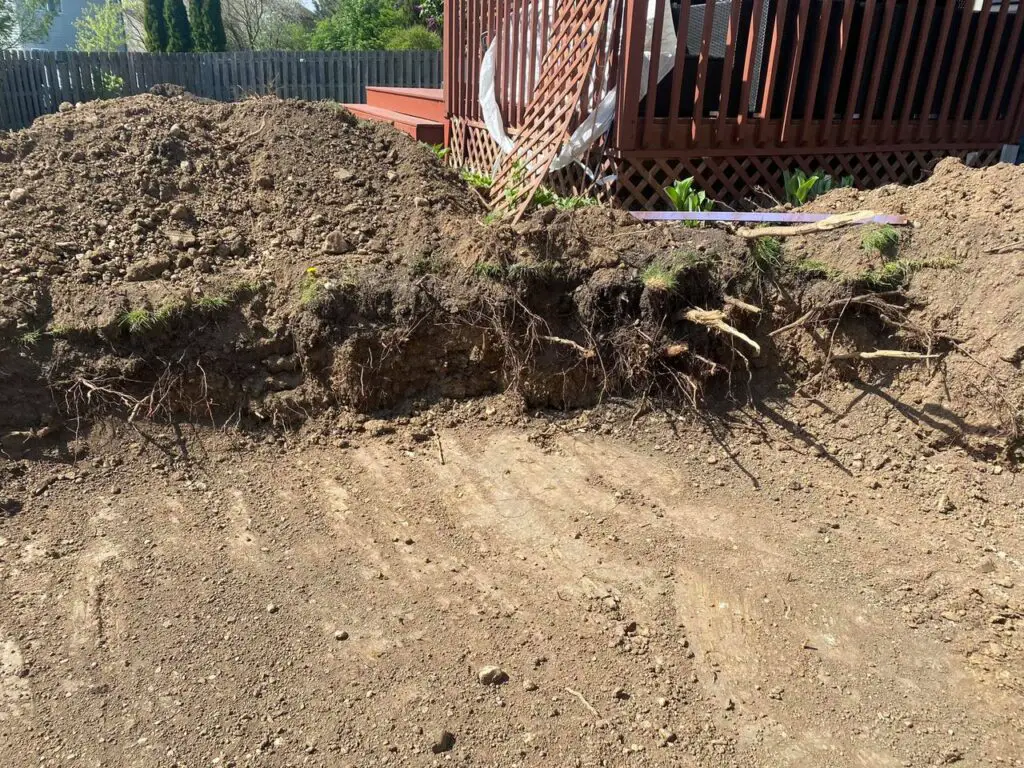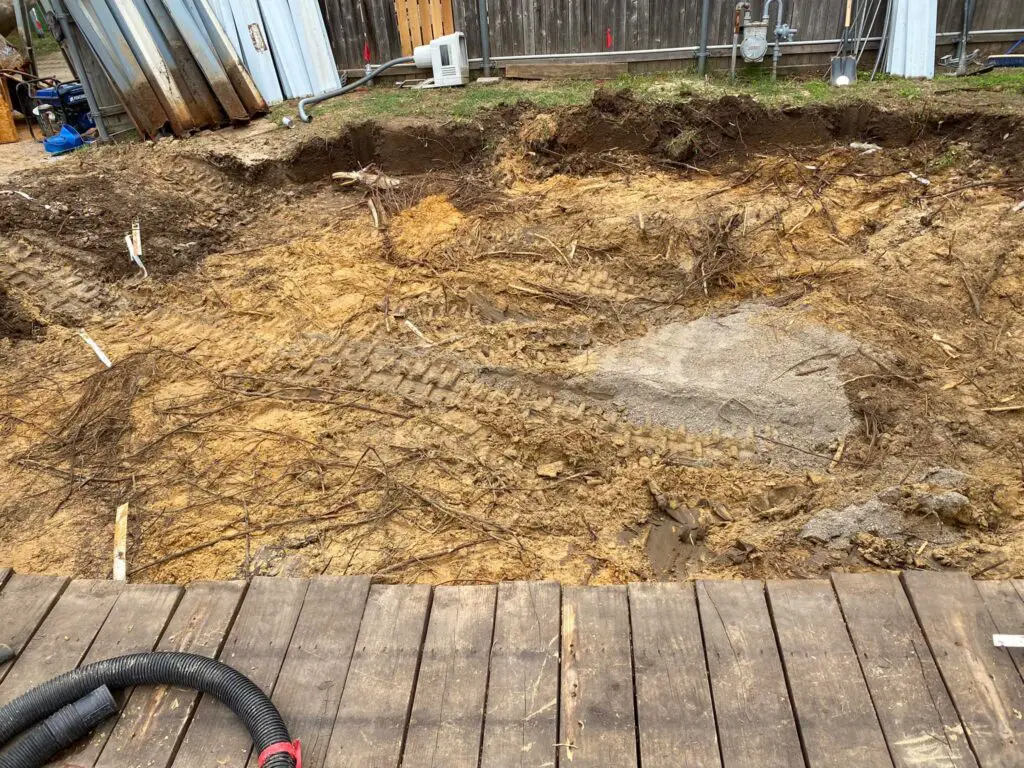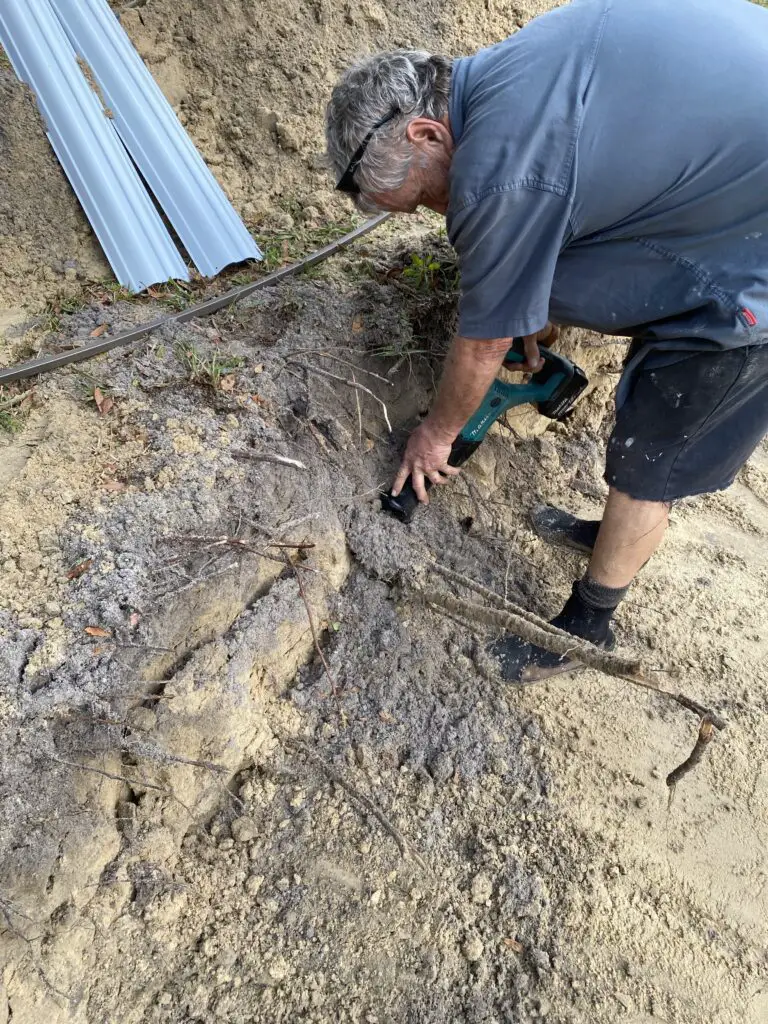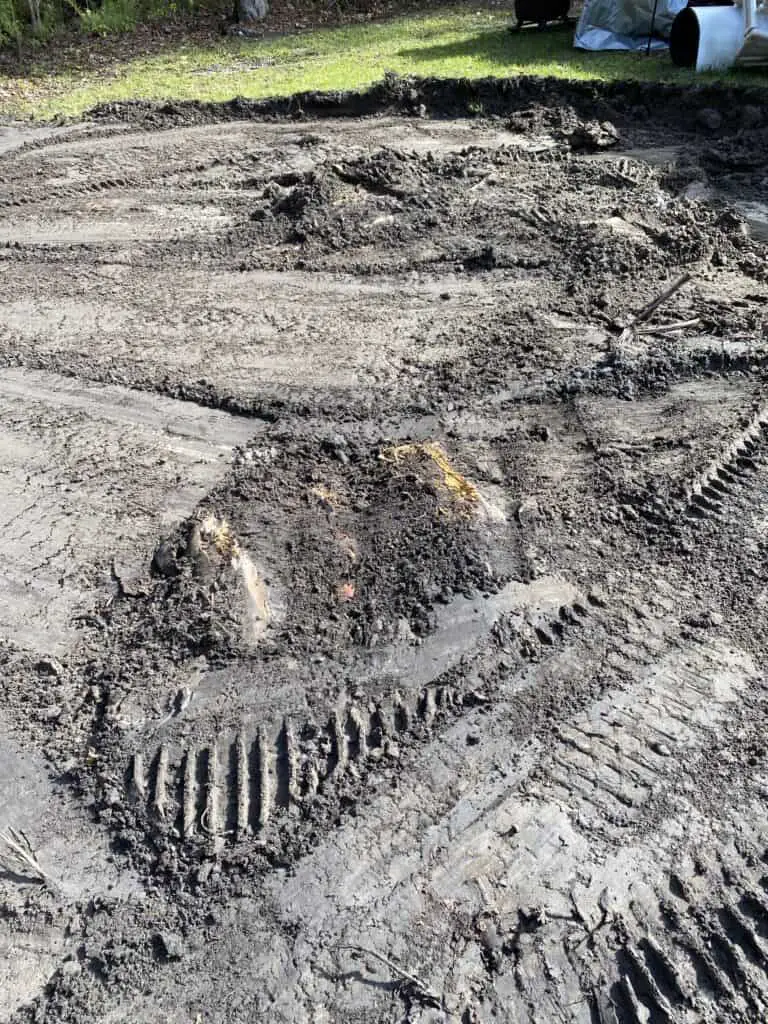Of all the things that you can find in the ground when installing an above-ground swimming pool, tree roots have the be the most common by far.
So, how do tree roots affect an above-ground pool? How do you deal with very large ones? Should they all be removed or do you just cover them? And what about tree stumps?
This article will answer the above questions and many more.
When installing an above-ground pool, all tree roots should be cut out from the site at least a couple of inches below the final floor level of the pool. Also, tree roots will grow back, but very rarely harm the pool’s liner.

REMOVING TREE ROOTS FROM AN ABOVE-GROUND POOL SITE
Above-ground pools are typically installed directly on the ground. And in case you don’t already know, all of the grass and root mass (sod) must first be removed, and then the ground nearly perfectly leveled.
When the grass is removed, this leaves the earth underneath and everything that is in it. And in most cases, roots will be in the ground.
Sometimes, you will clearly know that there will be roots in the ground as there are trees nearby where you are putting the pool up. Other times there will be roots and you have no idea where they are coming from.

There can also be roots in the ground from a tree that has long been cut down. The tree can be gone for a couple of years but its roots can still be dead in the ground getting in the way of your pool installation.
Most roots are small and some are quite big. Regardless of the size, they should all be removed when installing an above-ground pool.
So, just to be clear “You must remove all roots from the pool site”
BEST WAYS TO REMOVE TREE ROOTS FROM THE GROUND BEFORE INSTALLING AN ABOVE-GROUND POOL
Just in case you need to qualify me, I have installed more than six thousand pools over a 37-year span. And in that time, I have installed pools next to giant oak trees, over canopies of trees in swampy areas, and discovered my fair share of buried tree stumps.
Here are the methods I use to remove roots from a pool site:
TOOLS USED TO REMOVE LARGE TREE ROOTS
A Skid/steer machine
In most cases, a do-it-yourselfer won’t have a skid/steer(Bobcat) type machine when installing their pool. I use one for every install though and must mention that they are excellent for getting out large tree roots.
Roots connected in the earth are harder to remove than you think. It takes a lot of weight and leverage to pull them up. A Bobcat-type machine can dig under and use its weight and hydraulics to lift bigger roots right out of the ground, which is wonderful.
A machine can expose and pull up roots from the pool site leaving you to only have to cut them from just beyond the site and completely remove them.
B Sawzall with a long wood-cutting blade

This is clearly my go-to tool for cutting out roots. Sawzalls have a vertical design, so with a longer blade, you can cut out roots fairly deep into the ground.
This is also maybe the safest electric or gas-powered cutting tool to use as the blade moves back and forth instead of in a circular motion.
C Old-school axe
There are some cases where a Sawzall-type tool cannot cut a root. Maybe the root is an odd shape or placement or it won’t cut because it’s moving too much (vibrating while being cut).
This is where a good old-fashioned axe comes into play. And I use them often enough to keep one on the truck at all jobs. Making sure your axe is very sharp is a big key to them working well.
NOTE: Knowing how to swing an axe is a lost art, so don’t just assume that you can do it well. I have taught more than a few young workers how to swing an axe and have watched how rewarding it is to learn how.
D Chainsaw
Chainsaws are dangerous. Period. Fortunately, a long-bladed Sawzall with a quality wood-cutting blade can cut very large tree roots successfully, so I only rarely have to use a chainsaw.
When using a chainsaw to cut out tree roots, you must be very careful or have a lot of chainsaw experience or both.
Often, you are cutting the roots towards the top of the chain bar, which makes the saw easier to jump off of the root and cut something else that you don’t want cut – like your foot.
Decide where you want to cut the root, dig out any dirt from around the area and maybe wash it clean with a water hose. Make sure your footing is good before you begin cutting and wear eye protection.
Scared to use a chainsaw to cut tree roots yet? Good. This will keep you focused.
TOOLS USED TO REMOVE SMALLER TREE ROOTS
A Square-head shovel with a sharp edge
Many don’t know about this trick, but you can sharpen a shovel’s edge, which makes all the difference in the world.
Shovels come with unsharpened edges. Use a grinding wheel or even a hand file and make your shovel sharp. You’ll then be amazed at how well it can cut things like roots.
A square head shovel is by far my first choice for cutting out smaller roots from a pool site. You can cut them fast and accurately with minimal energy.
B Sawzall with a wood-cutting blade
Sawzalls are good for both large and small roots. It is fast, effective, and roots can be cut below the ground level.
A cordless Sawzall is best for this as you can move and cut fast if there are a lot of small roots.
C Machete
A machete is not a tool that I keep on my truck, but this is an excellent tool for cutting smaller roots. Making sure it has a nice, sharp edge on it will make a big difference too.
D Sodcutter machine
This may sound like an odd addition to this list, but sod cutters are excellent for cutting lots of smaller roots in the ground.
About 25 years ago, I used to install pools using a sod cutter. This was before a bought and started using a skid/steer machine. In those days, I would use the sod cutter to cut the pool site after it was leveled just to make sure there still weren’t any small attached roots left in the earth.
A sod cutter can cut down four inches in the ground using a long blade (12” or 18”) that cuts horizontally. This is how it cuts sod so you can easily remove it from the ground.
Running the sod cutter all over the pool site one last time after the grass has been removed and the ground level can help ensure that there aren’t still any small roots that are still attached to a root system.
TREE ROOTS LEFT IN THE GROUND OF AN ABOVE-GROUND POOL SITE ARE OK AS LONG AS THEY HAVE BEEN CUT
Connected tree roots have amazing strength. They can be small and easily break, but when networked together and slightly under the ground, they can prevent giant trees fifty feet high from coming down during hurricane-force winds.
Small things like rocks, glass, debris, and roots can be left in the ground and under a pool’s bottom and not cause any issues. Often, if something is felt under a liner by a swimmer, it can be pushed or tapped downward in the ground and never felt again.
So, if a small root is left in the ground and it is protruding, then it too can just be tapped down below the pool’s bottom level and it is fine.
If a tree root is left in the ground AND is still attached to the other roots in the ground, then that is bad. It’s bad because you won’t be able to push or tap it down.
An attached root will stay where it is and the only way to not feel it will be to drain the pool, peel back the liner, cut it out, replace the liner, and refill. NOT GOOD.
TREE STUMPS AND ABOVE-GROUND POOLS
I want to clear something up for some – “A tree stump is not a tree root”.
Over my many years of installing pools, I have had many pool owners treat having a tree stump where they want their pool as no big deal.

If you think this and are about to self-install your own pool where there is a tree stump, get ready for some fun.
With tree stumps, you have two choices. You can either dig around it and completely remove it (like a bad tooth) or you can grind it down below the level of where the pool’s bottom will be. You can’t just cut it out like it’s a root. It won’t do that.
If you choose to remove the stump, it will be a special kind of fun to do. Be patent, dig around it and under it a lot (more than you think you need to), and cut all the roots that are attached to it all the way around it. Just one root left attached to it will sometimes keep it in the ground.
If you choose to leave it, just know that the bottom track of the pool will have to sit higher than the highest part of the stump, or you’ll feel it later in the pool.
You can have a stump grinding guy come out and grind it down some. I usually recommend this as they don’t charge that much and it doesn’t take much time for them to do it.
You can also grind some of the stump down yourself. I have been in situations where I need to get the stump down just an inch or two. For that, I have used a chainsaw, a circular saw (not recommended), and even an axe to grind or chip the level down some.
A COUPLE OF TIPS FOR CUTTING LARGE TREE ROOTS FROM AN ABOVE-GROUND POOL INSTALL SITE
1 Cut roots off at least one foot away from where the pool is going
As an example, if you are installing a 24’ round pool, make a 26’ circle and remove all of the roots that far out. If you cut roots out too close to where the pool is going, you may have to cut more of them later as they may be in the way of the installation.
2 Dig around the large roots before cutting them
Cutting large roots out of the ground can be a pain in the rump. You will be tempted to try to cut them out without knowing their size or where they are going (as they will be covered with dirt).
Doing the extra work of digging around where you want to cut first will save you a lot of time and energy. If you don’t do this, you will be making a lot more cuts than you have to. And when it’s hot out, that can wear you out.
3 Use water to clean dirt from the cut area
If you can, it may be very helpful to wash away all the dirt that is in the way of where you want to cut out large roots.
The drawback here is that you don’t want to get the site too wet and muddy, so if the water isn’t going into the ground quickly, don’t use water.
4 Cut the roots well below the level of the pool’s bottom
When working on the earth of an above-ground pool site, it can be hard to tell what level the pool will wind up sitting at. In many cases, the pool will sit lower in the ground than you think.
Because of this, make very sure that you cut these roots down in the ground far enough so they won’t be in the way later.
I can’t tell you how many times I’ve had to cut difficult roots twice because I didn’t cut them far enough away the first time. Yeah, that’s more annoying than you think, especially when it’s 100 degrees out.
TREE ROOTS WILL GROW BACK, BUT DON’T WORRY ABOUT IT
Unless you remove the tree that made the roots, they will grow back where you cut them out. Sometimes they grow back even when the tree is removed.
This is unavoidable but you don’t have to be concerned about it. The roots will grow back under the pool and some will grow up right next to the liner.
The good news is that the roots will very, very rarely cause any issues with the liner. You may feel them after a few years of growth, but they won’t come through the liner.
Some will think that a root made a hole in their liner, but what happens with that is when liners get old, they get brittle. And when they get brittle, they can first crack in areas like where roots have grown up. And when brittle liners start cracking, they are done.
Any fear of sinkholes after the stump and roots rot? Should you compact the soil after removing a stump and roots?
Yes but don’t get too crazy about how. Packing the earth with your foot while filling in the void is all that you need. You can water it down to get any air out of the earth too while filling in.